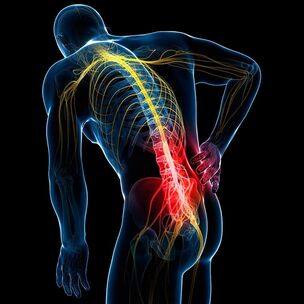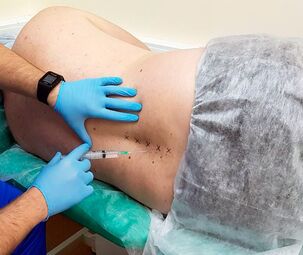According to medical statistics, acute back pain is the second most common cause of disability. At least 80% of people have suffered from them at least once. It can sometimes occur or be accompanied by exacerbation of spinal diseases. But in any case, acute and chronic back pain require competent treatment and purposeful action on the causes of their occurrence.
Acute low back pain: causes

Acute pain is pain that lasts less than 6 weeks. For most, it disappears in 2 weeks. It is impossible to predict how long it will initially last. However, in almost half of the cases, similar or more severe attacks recur in the future and turn into chronic pain.
Acute pain can be of varying intensity, dull, burning, etc. Sometimes it spreads to the arms, legs and thighs. The so-called back pain often occurs as a result of hypothermia, excessive physical exertion and twisting. It can take several days between the effects of the traumatic factor and the direct manifestation of the pain syndrome, and this will manifest itself under the influence of insignificant physical effort.
These can also be the result of a spinal cord injury or the first manifestation of a spinal disease:
- osteochondrosis;
- intervertebral hernia;
- spondyloarthritis;
- spinal stenosis, etc.
Increase waist problem:
- frequent stress;
- regularly increasing physical activity;
- overweight;
- stop often and for a long time.
In addition to severe back pain, there may be headache, burning sensation in the legs and dizziness. All these symptoms should be reported to the doctor at the appointment.
Regardless of which anatomical structure is initially damaged, it causes a whole chain of successive changes that increase anxiety. Initially, the lesion develops inflammatory factors, swelling and irritation of nerve fibers. In response, muscle spasms often occur, which exacerbates the condition and provokes poor circulation in the affected area. This leads to a decrease in the amount of nutrients and oxygen entering the lesion focus and the retention of metabolic products in it.
Treatment of acute low back pain
Lie on your back on a hard surface to reduce pain. This will allow your back muscles to relax and reduce stress on your spine. To increase the effect, orthopedic pillows can be placed under the knees and under the head, but it is important to avoid sagging in the lower back. With severe pain, short-term NSAIDs are allowed. Be sure to contact a neurologist or spinal surgeon to determine the cause of your pain syndrome in the future.
You should see a doctor as soon as possible within a week in case of improvement, recurrence of an attack or radiation to the pain in the legs or knees, urinary incontinence and defecation. Patients are shown to identify existing disorders:
- MRI;
- CT;
- x-ray;
- biochemical blood test;
- UAC.
Based on the results of the study and the characteristics of the symptoms, the doctor makes a diagnosis and develops treatment tactics. In the case of severe pain that deprives a person of the ability to work, he may be offered a spinal block, which eliminates the pain syndrome in a few minutes.
It is important not to sleep in bed after anxiety. Moderate physical activity, complemented by special exercises in medical gymnastics, is the best way to prevent the recurrence of such attacks in the future.
By visiting the hospital, you will definitely receive quality treatment for pain syndrome and its causes. Specialists will develop the most effective treatment tactics and quickly relieve pain with a well-prepared, affordable blockade.
Chronic back pain: causes
People suffer from chronic back pain. They can be exacerbated and turn into a sharp attack of pain, which completely extinguishes the person from the usual rhythm. Often the result is:
- A sedentary lifestyle that weakens the muscular corset. This causes an increase in the load on the spine and compression of the vertebrae. The result is osteochondrosis, a protrusion of the intervertebral discs and herniated discs, spondyloarthritis.
- Posture disorders. Prolonged protection of any position of the body where the natural curves of the spine are violated leads to its curvature and the development of scoliosis or kyphosis. This leads to degenerative changes in the intervertebral discs, redistribution of the load on the muscles and compression of the nerve roots.
- Weakening of the abdominal muscles. When they are weak because they play a supporting role for the internal organs and partially relax the spine, the load on the waist increases, which increases lordosis and causes chronic pain. In addition to a sedentary lifestyle, weakening of the abdominal muscles can be the result of pregnancy or obesity.
- Age changes. Over the years, the intervertebral discs gradually become dehydrated, leading to a decrease in elasticity, strength, and size. The ring fibrosis that surrounds the jelly-like nuclear pulp dries out and becomes more brittle. Loads stimulate the formation of cracks inside, which leads to the formation of protrusions and hernias. The resulting bulge can compress nearby blood vessels, nerve roots, and the spinal cord, causing pain to appear.
Chronic low back pain includes:
- osteochondrosis;
- spondyloarthritis;
- osteoporosis;
- intervertebral hernia;
- facet syndrome;
- ankylosing spondylitis;
- spondylolisthesis;
- rheumatoid arthritis;
- intercostal neuralgia;
- oncological diseases, etc.
A common cause of chronic pain is deterioration of the facet joints. The cartilage in them also tends to thin with excessive stress on the spine. As a result, as they move, they stop performing a shock-absorbing function that causes bone fragments to rub and inflammation to develop.
Back Pain Treatment
Treatment tactics are based on what abnormalities are detected during diagnostic tests. When spinal diseases are detected, conservative therapy is prescribed first:
- drug treatment;
- physiotherapy;
- massage;
- exercise therapy.
Conservative therapy
A holistic, individualized approach is important when treating low back pain. Depending on the cause, patients are prescribed a number of drugs, in particular:
- NSAIDs - drugs in this group have anti-inflammatory and analgesic effects, but with long-term use adversely affect the condition of the digestive system;
- corticosteroids - drugs with moderate anti-inflammatory properties, prescribed in moderate cases;
- muscle relaxant - helps relieve increased muscle tone and spasms;
- antidepressants - help to eliminate psychological anxiety, which often reduces the effectiveness of conservative therapy;
- Topical ingredients - ointments or gels with anti-inflammatory, warming or cooling components can help reduce the severity of pain and practically do not cause side effects;
- Chondroprotectors - preparations containing glucosamine and chondroitin have a beneficial effect on the condition of cartilage tissue, increase its elasticity and help restore normal thickness.

In mild cases, it is enough to take oral medication. However, in more complex cases, patients may be prescribed intra-articular injections. In case of severe pain, it is recommended to perform blockades, which can cover up to 10 procedures at once or as a whole course.
To increase the effectiveness of drug treatment, patients are prescribed massage sessions and physiotherapy. Proper exposure to the back muscles helps to activate blood and lymph flow, improve metabolic processes and relieve muscle spasms. Manual therapy is very effective in spinal deformities, especially in scoliosis of 1-2 degrees. Regular sessions help to restore the normal position of the spine and reduce the pressure on the internal organs.
As part of physiotherapy, sessions are scheduled for patients:
- UHF;
- magnetic therapy;
- Bernard currents;
- laser therapy;
- electrophoresis;
- UFO;
- balneological treatment.
If the condition cannot be improved within six months or there is a risk of complications, patients may be offered surgical treatment for existing illnesses.
Surgical Treatment
Modern surgical interventions are characterized by high efficiency and safety. They allow to quickly eliminate the pathological cause of the development of pain syndrome and do not require frequent hospitalization. However, most minimally invasive and microsurgical techniques can only be used when patients seek spinal surgeons in the early stages of the disease.
Indications for surgical treatment:
- intervertebral discs with progressive hernia;
- spinal stenosis;
- separated hernia;
- spinal fractures;
- 3-4 degrees scoliosis;
- severe forms of spondyloarthritis;
- compression of the spinal cord or its nerve roots;
- hemangiomas of vertebral bodies;
- instability of individual segments of the spine;
- cauda equina syndrome.
The surgeon determines the type of operation based on the severity of the patient's condition. Surgical treatment with the same diagnosis can be performed in different ways, differing in the degree of invasiveness, effectiveness, duration and cost of rehabilitation.
Recently, minimally invasive surgical treatments have become very popular. They are used to treat intervertebral disc herniation, intervertebral disc herniation, hemangiomas and a number of other diseases. Minimally invasive surgery does not take more than an hour, and upon completion, the patient can walk almost immediately and leave the clinic the same day or the next day.

The great advantages of the method are a good cosmetic effect (in most cases, all the necessary surgical instruments are applied through the perforation of soft tissues), ease of rehabilitation and an affordable price. In the case of an intervertebral hernia, only cold plasma nucleoplasty or hydroplasty (hydrosectomy) may be considered a more promising method.
In cases where microsurgery cannot be applied, surgeons perform open operations. During this, it is possible to completely eliminate pathologically altered formations, correct sharp deformations of the spine, replace irreversible structures with implants and achieve normal functioning of the spine by installing metal-titanium structures.
Modern spinal surgery combats almost any back problem. All the latest methods of surgical treatment of spinal diseases are available in many institutions. A team of doctors with different profiles will help you get rid of acute or unbearable chronic back pain as soon as possible.
Prevention of low back pain
It is recommended to avoid a second episode after the seizure is over and the pain subsides:
- Do not lift very heavy objects;
- do not bend;
- walk more;
- to give up heavy physical labor; Take regular breaks to warm up while sitting
- .



































